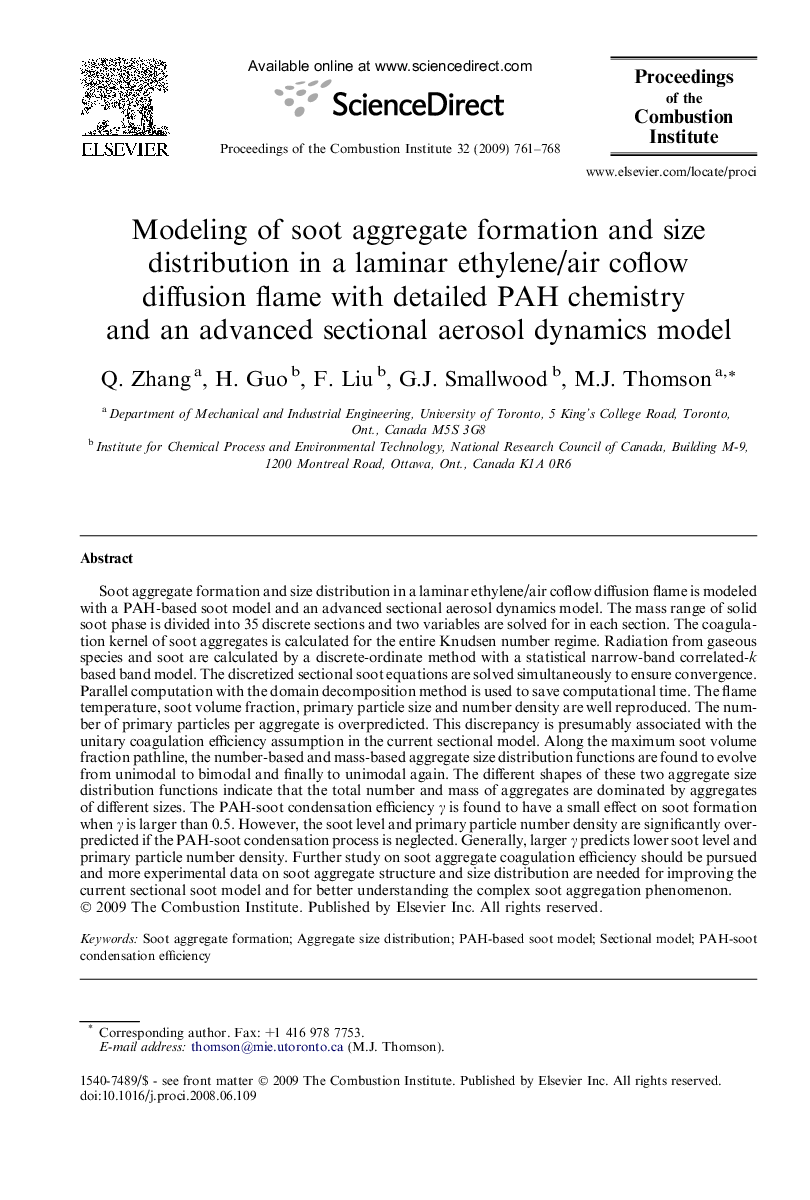| کد مقاله | کد نشریه | سال انتشار | مقاله انگلیسی | نسخه تمام متن |
|---|---|---|---|---|
| 6679472 | 1427927 | 2009 | 8 صفحه PDF | دانلود رایگان |
عنوان انگلیسی مقاله ISI
Modeling of soot aggregate formation and size distribution in a laminar ethylene/air coflow diffusion flame with detailed PAH chemistry and an advanced sectional aerosol dynamics model
دانلود مقاله + سفارش ترجمه
دانلود مقاله ISI انگلیسی
رایگان برای ایرانیان
موضوعات مرتبط
مهندسی و علوم پایه
مهندسی شیمی
مهندسی شیمی (عمومی)
پیش نمایش صفحه اول مقاله

چکیده انگلیسی
Soot aggregate formation and size distribution in a laminar ethylene/air coflow diffusion flame is modeled with a PAH-based soot model and an advanced sectional aerosol dynamics model. The mass range of solid soot phase is divided into 35 discrete sections and two variables are solved for in each section. The coagulation kernel of soot aggregates is calculated for the entire Knudsen number regime. Radiation from gaseous species and soot are calculated by a discrete-ordinate method with a statistical narrow-band correlated-k based band model. The discretized sectional soot equations are solved simultaneously to ensure convergence. Parallel computation with the domain decomposition method is used to save computational time. The flame temperature, soot volume fraction, primary particle size and number density are well reproduced. The number of primary particles per aggregate is overpredicted. This discrepancy is presumably associated with the unitary coagulation efficiency assumption in the current sectional model. Along the maximum soot volume fraction pathline, the number-based and mass-based aggregate size distribution functions are found to evolve from unimodal to bimodal and finally to unimodal again. The different shapes of these two aggregate size distribution functions indicate that the total number and mass of aggregates are dominated by aggregates of different sizes. The PAH-soot condensation efficiency γ is found to have a small effect on soot formation when γ is larger than 0.5. However, the soot level and primary particle number density are significantly overpredicted if the PAH-soot condensation process is neglected. Generally, larger γ predicts lower soot level and primary particle number density. Further study on soot aggregate coagulation efficiency should be pursued and more experimental data on soot aggregate structure and size distribution are needed for improving the current sectional soot model and for better understanding the complex soot aggregation phenomenon.
ناشر
Database: Elsevier - ScienceDirect (ساینس دایرکت)
Journal: Proceedings of the Combustion Institute - Volume 32, Issue 1, 2009, Pages 761-768
Journal: Proceedings of the Combustion Institute - Volume 32, Issue 1, 2009, Pages 761-768
نویسندگان
Q. Zhang, H. Guo, F. Liu, G.J. Smallwood, M.J. Thomson,